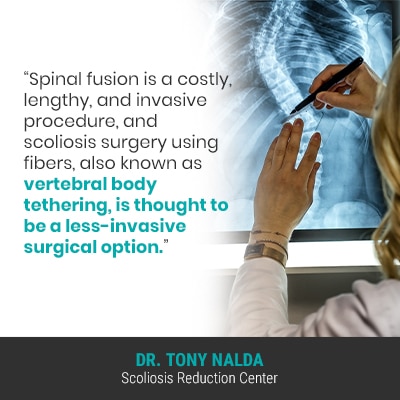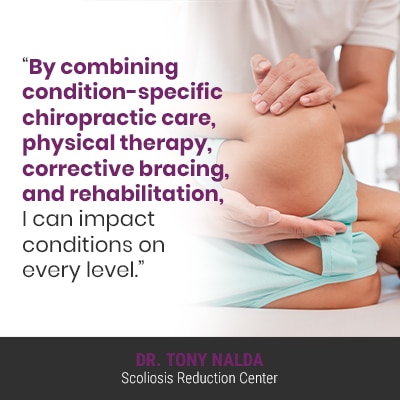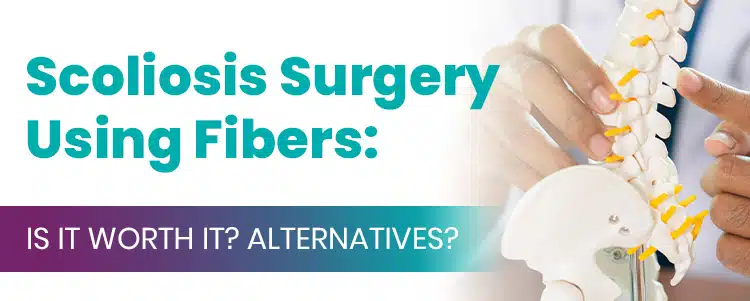While scoliosis surgery can help straighten a crooked spine, like many surgical procedures, it comes with its share of serious potential risks, side effects, and complications. Many patients find their back pain increases post-surgery and they have a noticeable loss of spinal flexibility and range of motion. Scoliosis surgery with fibers was developed as a less-invasive surgical treatment option, but it also has risks to consider.
Scoliosis surgery using fibers is also known as vertebral body tethering, and it’s thought to be less invasive than traditional spinal fusion surgery, but both carry risks so should be considered carefully. In addition, not all cases of scoliosis require surgery.
There are different approaches to treating scoliosis, both surgically and non-surgically, so let’s explore the different types of results achieved by each.
Scoliosis Treatment Options
First of all, what is scoliosis? Scoliosis is a highly-prevalent structural spinal condition that involves the development of an unnatural sideways spinal curve, with rotation.
It’s the rotational component that makes scoliosis a complex 3-dimensional condition, and this is an important feature when it comes to the different treatment approaches.
Scoliosis ranges from mild to moderate and severe to very severe, and severity is determined by a measurement known as Cobb Angle, and a patient’s Cobb angle is a determining factor when it comes to whether or not a surgical recommendation is given.
Scoliosis, as a progressive condition, has it in its nature to worsen over time, so where a scoliosis is at the time of diagnosis doesn’t indicate where it will stay; managing progression is why proactive treatment is so important.
Scoliosis progressing means the unnatural spinal curve is increasing in size, as are the condition’s uneven forces, and their effects.
As scoliosis gets worse, the spine gets more rigid, making it less responsive to treatment, and making it more challenging for patients to perform certain therapeutic exercises and stretches that are a key facet of treatment.
So the message here is the value of being proactive, and while one of the main scoliosis treatment approaches is proactive, the other is more reactive; let’s talk about the difference.
Traditional vs Conservative Scoliosis Treatment
Traditional scoliosis treatment is described as reactive because it doesn’t have a strategy for treating scoliosis while mild, and more so reacts once it’s progressed across the surgical threshold.
For those on the path of traditional treatment, the recommendation to watch and wait while conditions are mild is common, and if a patient progresses into the severe classification with a Cobb angle measurement of 40+ degrees and shows signs of continued progression, this is when surgery is often recommended.
Scoliosis surgery is spinal fusion, and while there are different types, traditional spinal fusion involves fusing the curve’s most-tilted vertebrae into one solid bone, removing intervertebral discs between fused vertebrae, and attaching rods with pedicle screws to the spine to hold it in place.
The spine’s design is based on movement, so fusing a spine and holding it in place through artificial means is contrary to its movement-based design, and in many cases, patients are disappointed with the level of spinal rigidity in the fused section.
While some patients maintain enough spinal flexibility above and below the fusion site to not experience a noticeable loss in range of motion, patients whose conditions are severe and require more vertebrae to be fused are more likely to experience this effect.

Spinal fusion is a costly, lengthy, and invasive procedure, and scoliosis surgery using fibers, also known as vertebral body tethering, is thought to be a less-invasive surgical option.
Scoliosis Surgery with Fibers
Scoliosis surgery using fibers is a type of vertebral body tethering (VBT) that developed as a less-invasive type of spinal fusion.
In vertebral body tethering, instead of using rods attached with screws to hold the spine in place, tension is applied to the spine by adjusting tethers attached to affected vertebrae with screws.
The process of VBT, also known as anterior scoliosis correction, involves making small incisions down one side of the patient’s body, known as portals.
A benefit of this strategy is that unlike spinal fusion that involves cutting muscles to access the vertebrae, muscles are gently pulled apart to facilitate spinal access: known as muscle sparing.
Accessing the spine in this manner has the benefit of an easier recovery and preserving spinal strength, function, and muscle health.
Through the portals, a scope and camera can pass to provide visualization of the spine.
Next, the surgeon attaches screws through the portals to the affected vertebrae, and these are attached to a flexible tether.
The theory is that tension on the tether can be adjusted as needed, pulling the tilted vertebrae back into alignment with the rest of the spine and reducing and/or eliminating the unnatural spinal curve.
This approach can be particularly helpful with younger patients whose spines are still growing as tension can be adjusted based on how the spine is responding to treatment and growth.
The benefit of scoliosis surgery with fibers instead of rods is that it’s better suited for young patients who have not yet reached skeletal maturity, is less disruptive to muscles, tends to be easier to recover from, and as there aren’t rods attached to the spine holding it rigid and immoveable in the fused section, more natural spinal strength, flexibility, and function is preserved.
Regardless of these differences, however, the reality is that many cases of scoliosis don’t require surgery, and there is a less-invasive non-surgical treatment approach with proven results.
Conservative Non-Surgical Scoliosis Treatment
Here at the Scoliosis Reduction Center®, I treat patients using a conservative chiropractic-centered treatment approach that proactively works towards corrective results that help patients avoid the need for invasive surgery in the future.
Rather than delaying the start of active treatment by watching and waiting, as this is wasting valuable treatment time, I start treatment as close to the time of diagnosis as possible.
Particularly when treating the most-prevalent form of scoliosis, adolescent idiopathic scoliosis, diagnosed between the ages of 10 and 18, as growth triggers progression, a recommendation to watch and wait can be particularly dangerous because this age group is subject to rapid and unpredictable growth spurts and rapid-phase progression.
And while little is done to prevent progression in traditional treatment, conservative treatment is all about working to prevent increasing condition severity and escalating symptoms by being proactive.
I integrate multiple different types of treatment into customized treatment plans so conditions can be impacted on every level.
The only type of treatment used in the traditional approach, prior ro surgery, is traditional bracing, but even this is limited in is efficacy because it only addresses scoliosis as a 2-dimensional condition, ignoring its rotational component.

By combining condition-specific chiropractic care, physical therapy, corrective bracing, and rehabilitation, I can impact conditions on every level.
Through a series of chiropractic techniques and manual adjustments, I can work towards adjusting the position of the most-tilted vertebrae back into alignment with the rest of the spine.
Once I start to see the type of structural results needed for a curve reduction, I shift the focus to increasing core strength through physical therapy so the spine is optimally supported by its surrounding muscles.
In addition, physical therapy for scoliosis can also help by improving posture and addressing any related muscle imbalance that’s developed.
Particularly for younger patients whose spines are still growing, corrective bracing can help augment corrective treatment results by pushing the spine into alignment.
As a progressive and incurable condition, continued effort has to be made to maintain treatment results, and this involves a series of custom-prescribed scoliosis-specific exercises to help patients establish a home-rehabilitation program for further stabilizing and healing the spine for long-term sustainable treatment results.
Conclusion
When it comes to treating scoliosis, the best time to start is always now; as a progressive condition, scoliosis only gets more complex to treat over time.
The different scoliosis treatment approaches offer patients different potential outcomes, so it’s imperative that patients, and their families, are aware of all treatment options available to them.
Also, patients need to make sure their treatment expectations are aligned with the reality of their potential outcomes.
When it comes to traditional treatment, we’re talking about a surgical response that can cost the spine in terms of its overall strength, health, and function.
The evolution of scoliosis surgery with fibers is thought to be less-invasive than traditional spinal fusion that uses rods permanently attached to the spine, but it still has its share of risks such as cord breakage, overcorrection, and the need for subsequent surgeries.
As there are less-invasive conservative treatment options available with proven results, the risks associated with scoliosis surgery should be considered carefully.
Fortunately, for those who choose to forgo a surgical recommendation, or who simply want to try a less-invasive treatment option first, conservative non-surgical scoliosis treatment can achieve curvature reductions while preserving spinal strength and function throughout treatment and beyond.




